In fire detection systems, CO sensors have emerged as critical components due to their unique ability to provide early warnings. This article explores the scientific principles, validated research, and practical applications of carbon monoxide detection technology in modern fire safety systems.

1. CO as a Primary Fire Indicator
During the initial stages of combustion, fires predominantly produce CO, CO₂, and H₂O. Among these, CO stands out for its early detection capabilities:
-
Earlier Detection: CO appears 20–60 minutes earlier than visible smoke particles.
-
Rapid Dispersion: With a density of 0.967 g/L (lighter than air), CO rises quickly to ceiling-mounted detectors.
-
Low Ambient Levels: Typical environments maintain CO concentrations <20 ppm, while fires cause significant spikes.
-
Smoldering Sensitivity: CO reaches detectable levels hours before smoke in slow-burning scenarios (e.g., upholstered furniture or office materials).
-
False Alarm Resistance: Common non-fire sources (e.g., kitchens) rarely exceed critical CO thresholds.
2. Scientific Validation of CO Detection
Global research confirms CO’s reliability as a fire indicator:
Key Studies
-
Jackson & Kobins (1994): Tested 6 EN-standard fire types, revealing CO production rates:
-
Wood open flame: 0.02 g/m²·s
-
Polyurethane foam: 0.12 g/m²·s
-
Heptane flame: 0.08 g/m²·s
-
-
Pfister (1997): Demonstrated CO concentrations exceeding 50 ppm within 5 minutes of ignition, triggering alarms 25 minutes earlier than smoke detectors.
UK Fire Safety Trials
-
CO sensors achieved 100% response rate across 6 EN fire types.
-
Traditional smoke/heat detectors showed 20–40% false-negative rates in controlled tests.
3. Technological Breakthroughs in CO Sensors
Early CO sensors faced limitations in sensitivity (±15 ppm error), power consumption (>50 mW), and cost. Modern advancements by ISWeek address these challenges:
TGS5141 CO Sensor
-
Ultra-compact design (20mm diameter × 6.5mm thickness)
-
Low power operation (<1 mA average current)
-
Certified to UL2034, EN54-31
-
Linear output range: 30–2,000 ppm
-
Calibration interval: >5 years
- Recommended:Equipped with TGS5141 Electrochemical Carbon Monoxide sensor module – AG-4-CO-M5141
TGS5042 CO Sensor
-
Wide voltage support (3.0±0.2V DC)
-
Enhanced anti-interference design (<2% H₂S cross-sensitivity)
-
RoHS compliance
-
Operating temperature: -10°C to 50°C
-
Lifespan: >10 years
- Recommended: Equipped with TGS5042 Electrochemical Carbon Monoxide sensor module – AG-4-CO-M5042(D)
4. Real-World Performance Data
Field tests validate CO sensors’ effectiveness:
-
Sealed closet smoldering: CO reached 67 ppm in 15 minutes.
-
Wastebasket fire: Threshold breached in 8 minutes.
-
Forced ventilation scenarios: Maintained >90% detection accuracy.
Modern semiconductor-based sensors now deliver:
✓ ±3 ppm precision
✓ 80% lower power consumption (standby <0.5 mW)
✓ 75% cost reduction vs. first-gen models
ISweek’s advanced CO sensor solutions are redefining fire safety standards with unparalleled early-warning capabilities. For detailed specifications or custom integrations, contact our team.








